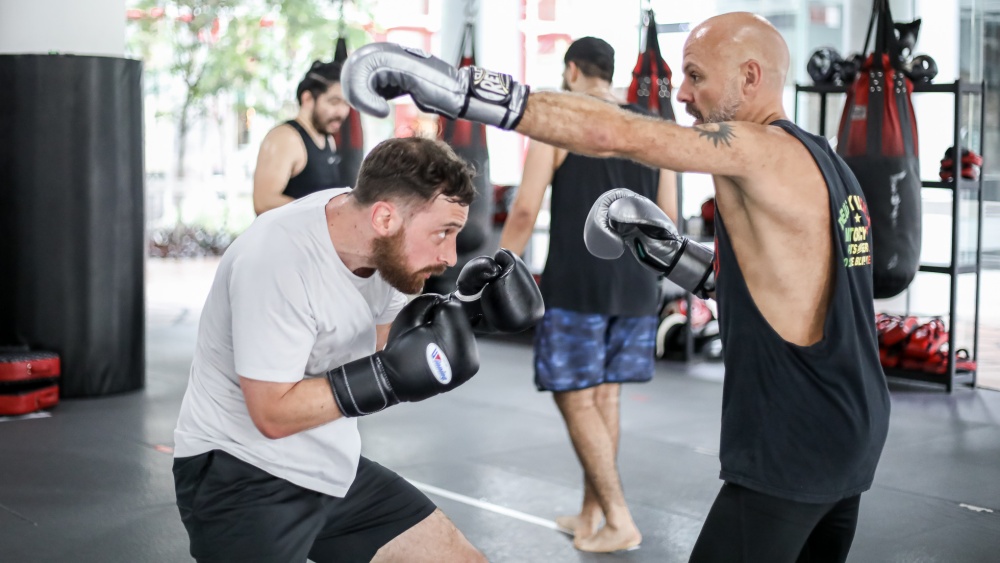The pawing jab won’t bring a fight to an end, but it can be an effective tool that sets up other punches that could leave your opponent unable to continue boxing. Used by legendary boxers like Muhammad Ali, this technique has stood the test of time.
The pawing jab is also one of the most versatile variations of the jab. It’s used as a range finder, to set up hard shots, or to bait opponents into throwing a punch at you as you leave your arm extended. This article will break down what the pawing jab is, why it’s used, and how it can improve your success inside the ring.
Understanding The Pawing Jab
While the pawing jab might look like a lazily thrown jab, everything about its mechanics is intentional. Unlike a conventional jab thrown with speed, the pawing jab is thrown slowly. Instead of snapping your arm at your opponent like a whip, you “paw” at them like a cat trying to get its owner’s attention. Doing so makes it easier to measure range, control distances, bait your opponent into throwing, and set up power punches.
Let’s take a closer look at some of the uses of the pawing jab:
- Distance Control: A pawing jab is a tactical measuring stick that you use to measure how far away your opponent is so you can make your next move. Knowing the distance between you and your opponents is crucial for avoiding counters and setting up combinations. You can also measure distance with a conventional jab, but a pawing jab gives you a better feel.
- Setting Up Power Shots: The pawing jab can be used to set up power shots by coaxing your opponent to move their guard in the direction you want, leaving them open for a sneaky uppercut, hook, or cross.
- Creating Distractions: Throwing a pawing jab leaves opponents momentarily occupied, increasing the odds that they miss what comes next. The slow speed of the punch temporarily blocks their line of vision, making it easier to sneak power strikes through their guard.
- Saving Energy: Throwing a pawing jab requires less effort than a conventional way, which makes it ideal for pressuring opponents while conserving your energy.
When To Use The Pawing Jab
Some of the best scenarios to use the pawing jab include:
- Against Defensive-Minded Opponents: Use pawing jabs to frustrate overly defensive opponents by forcing them to constantly react to your attempts to block their vision and move their guard. Any movement an opponent makes to knock a pawing jab out of their face leaves them vulnerable to counters.
- To Confuse Opponents: Mix your pawing jabs with feints to get your opponent to start swatting at air whenever you feint a jab.
- To Close Distances: Pawing jabs work well in that middle range where you’re not quite close enough to land combinations but don’t want to back away. You can keep your opponent busy with a pawing jab while you close down on them.
How To Throw A Pawing Jab
Ready to add the pawing jab to your collection of fighting techniques? Here’s a step-by-step breakdown of its mechanics:
- Get into your boxing stance with your guard high and your weight evenly distributed.
- Slowly extend your lead hand as you would when throwing a jab. Don’t worry about turning your hips or pivoting your lead leg. You’re not trying to land with significant power when using this technique. The goal is to block your opponent’s vision by aiming at space in front of their face or touching their guard. Don’t commit to the punch; you simply extend your arm to gather information.
- Bring your hand back to your guard.
Pay attention to your opponent’s reaction whenever you use a pawing jab while sparring or competing. Do they lean back? Block high? Or try to throw a counter a counter while your arm is extended. Look for openings you can exploit and follow up with a cross, hook, or uppercut.
Examples Of Fighters Who Use The Pawing Jab Effectively
Some of the fighters you should watch tapes on to master the pawing jab include:
- Floyd Mayweather: Mayweather used a pawing jab in almost all of his fights, typically using it to set up a hard cross. You can learn a lot from his fight against Saul “Canelo” Alvarez, who he toyed with throughout the fight with pawing jabs.
- Jon “Bones” Jones: If you thought pawing jabs only worked in boxing, think again. Many MMA fighters also use the technique, and Jones is one of the best at it. He often throws pawing jabs at his opponent’s legs to set up his trademark spinning elbows.
- Thomas Hearns: Some boxing aficionados will argue until they’re exhausted that Hearns is the best at using the pawing jab. It’s hard to argue against the tape, given how much success he enjoyed with it during his many classic brawls inside the ring, using the pawing jab to set up the straight right hands that earned him the nickname “The Hitman.”
Common Mistakes To Avoid
While a pawing jab can be an effective tool during fights, misusing it can leave you open to counters. Some of the common mistakes you should try avoiding include:
- Dropping Your Guard: Pawing too lazily leaves you to counters, particularly hooks and overhands. Be ready to block incoming strikes with your rear hand or lead shoulder when throwing it.
- Overuse: As is the case with other boxing techniques, you don’t want to overuse your pawing jab. Mix up your timing when throwing it, and use snappy jabs so your opponent is never quite sure about what’s coming next.
A Great Tool In The Box
The pawing jab can effectively set up your power strikes and manage distances during a fight. It’s a simple technique to master, yet it can massively impact how successful your other strikes are. Try incorporating the pawing jab and see how it’ll improve your boxing game!
You may also like:

















